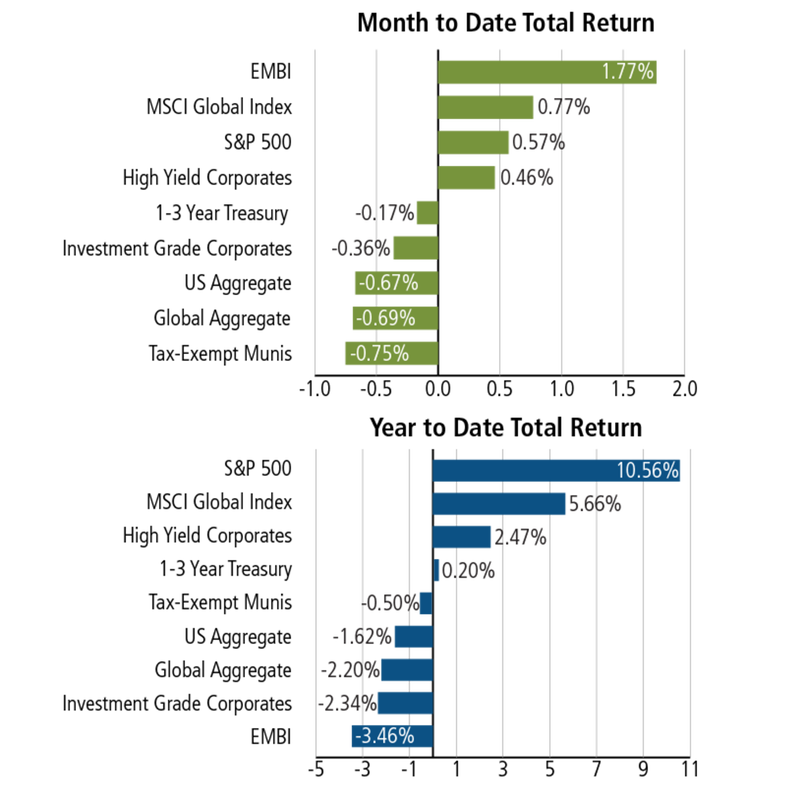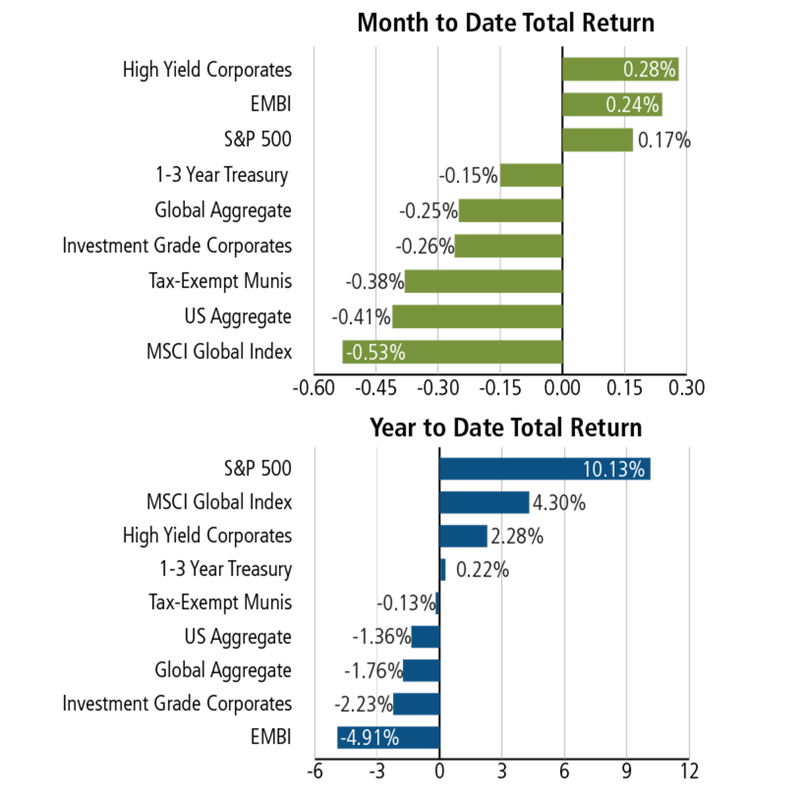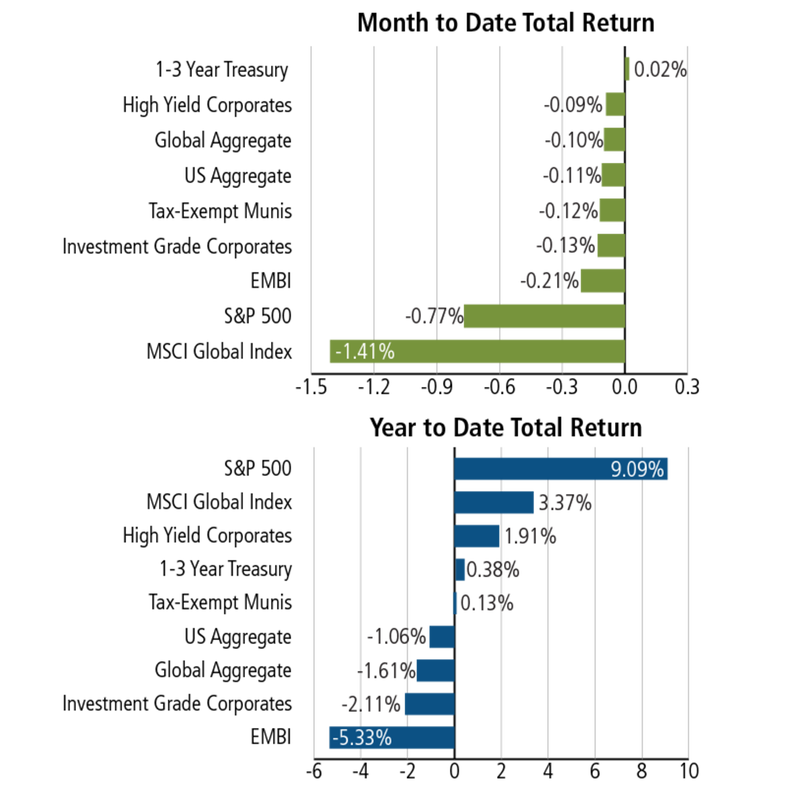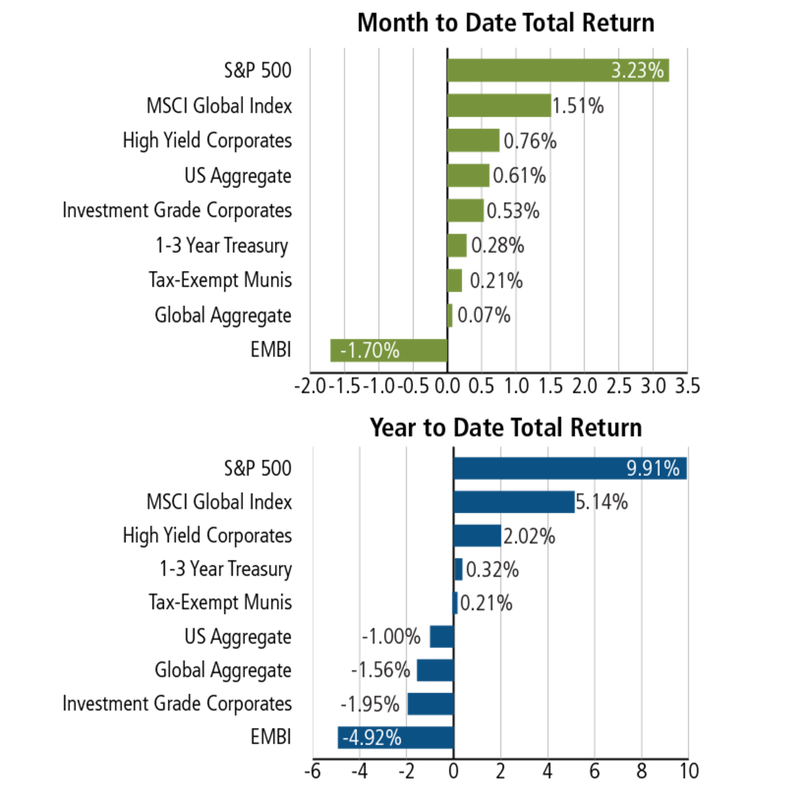|
-September 29, 2018 Weekly Capital Market Update. The S&P 500 lost -0.54%, Dow Jones Industrial Average fell -1.9%, while the Nasdaq rose +0.74% for the week. The broad S&P 500 US equity index was hurt by drops in financials and materials stocks after the Fed raised interest rates 0.25% and signaled a continued gradual path of increases. The Dow Jones Industrial Average as heightened trade tensions stoked cautiousness among investors. China cancelled upcoming high-level trade talks after the U.S. imposed its latest round of tariffs which prompted China to publish a white paper attacking the "protectionist" and "trade bullyism" practices of the U.S. administration. The U.S. and Mexico plan to release the draft of a new NAFTA agreement even though trade talks with Canada have stalled. We look for the upcoming earnings season to add positive traction to the generally favorable outlook of the global economies. -September 21, 2018 Weekly Capital Market Update. Both the S&P 500® and Dow Jones posted record highs on Thursday as the longest bull market on record continued with both U.S. equity indexes posting positive returns for the week of +0.86% and +2.25%, respectively. In turn, the Nasdaq lost on the week with a -0.29% showing. There appears to be an undercurrent of emerging trading patterns which hint toward a rotation from the Technology sector, and defensive stocks, into cyclical stocks in the Financial, Industrial, Energy and Consumer Discretionary sectors. The market is also digested another announcement of additional trade tariff ($200 Billion on China), which generated only a muted market reaction; however, some companies indicated steps they may take to mitigate higher prices if the tariff continues. Federal Reserve officials will meet next week on September 25-26 to set monetary policy. It's widely expected that the Federal Open Market Committee will raise the federal funds target range by another 25 basis points, to 2.00-2.25%. Analysts will focus primarily on the post-meeting commentary by the four Fed governors where the market expects revised projections of growth, unemployment, and inflation (extending out to 2021). Goldman Sachs recently went on record that there is only a 36% chance of recession in the next three years, a figure below the historical average. “There has been increasing investor interest in the chance of a recession in the U.S. over the next few years … Our model paints a more benign picture”, said Goldman Sachs’ economist Jan Hatzius. It is important to be mindful that almost all bear markets on a historical basis have been preceded by early stage economic recessionary trends. -September 14, 2018 Weekly Capital Market Update. Broad U.S. equity markets continued their upward trajectory with the S&P 500 gaining +1.16%, Dow Jones returning +0.92% and Nasdaq jumping +1.36% for the week. Economic data, including the Consumer Confidence Index, continue to support the markets with a robust reading of 100.8 for August, which was the second highest since 2004. Furthermore, another (trading) barometer for overall economic health is the S&P 500’s Transportation Index and with that up +9% YTD; from that technical indicator things also appear sanguine. Furthermore, on the job employment front, wage growth accelerated while the jobless rate is at a 50 year low. Separately, trade negotiations continue with Canada while China and the U.S. are in discussions for new rounds of trade negotiations. Politically, the U.S. mid-term elections leave party house control for Congress up in the air. Looking forward to third quarter earnings (3Q18), analysts expect companies to report earnings growth of +19.9%, partly driven by projected revenue growth of +7.5%. Finally, in a recent Fed publication of “3-month to 10-year curve” by the San Francisco region, it is notable that the expressed view is recessions typically occur a ‘year or two after the curve inverts’ (where the 3-year treasury yield moves higher than the 10-year treasury). As we stand today, there is a positive spread of 80 basis points between these two yield maturity points and therefore nothing foreboding. -September 7, 2018 Weekly Capital Market Update. The month of September started with a rocking start bringing across-the-board equity market declines; this was in response to uncertainties related to the discord in the Trump Administration, lower oil prices and headwinds associated with China tariffs and the NAFTA negotiations with Canada. All U.S. equity market indices showed weakness for the week with the S&P 500 Index declining -1.03%, Dow Jones Industrial Average edging downward -0.19% and the Nasdaq collapsing -2.55%. Recent polls have shown strong gains for Democrats, raising the prospect that the party will take back the House and maybe even the Senate. So what would that mean for stocks? Well, the historical picture is mixed. Overall, stocks typically have a tough September heading into the November midterms. However, immediately before and after the election, markets are relatively unaffected, no matter the outcome. Generally speaking, from the beginning of October until the end of the year (in a midterm year), stocks rally strongly. Looking at the heated and divisive political situation today, it is in an investor's best interest to understand that insofar as ongoing Trump turmoil may increase market volatility (at times), it is important to keep focused on what has been driving the market trends over time: Fed policy, availability of credit, economic growth, and robust earnings. LPL Research has assembled a recession watch indicator that shows low risk for a recession in the next year, while ISM Manufacturing index rolled in at 61.3 versus the estimate of 57.5. Moreover, comments from the business leader panel reflect continued expanding business strength. Looking ahead to Q3 2018, the estimated earnings growth rate for the S&P 500 is 20%. If 20% is the actual growth rate for the quarter, it will mark the third highest earnings growth since Q3 2010 (34.1%). -September 1, 2018 Weekly Capital Market Update. U.S. equities markets accelerated their upward path with the S&P 500 +0.93%, Dow Jones +0.68% and the Nasdaq +2.06% for the week. The uptrend remains in place with all sectors participating in a broad, across-the-board rally with five positive months in a row for the S&P 500; this potentially signals further strength lies ahead. Major contributing factors to the positive equity market trajectory included solid earnings, economic reports, and commentary by Federal Reserve Chairman Powell, which reinforced the expectation of gradual interest rate increases. Furthermore, positive trade alliance developments were accomplished with the U.S. and Mexico. Elsewhere, the U.S has not reached an agreement with Canada and the European Union as President Trump appears ready to move forward on the proposed $200 billion in tariffs on Chinese imports next week. Also, investors will closely monitor the upcoming mid-term elections, and the potential shift in party control of Congress - any shift of party control has the potential to increase market volatility.
|
Follow us on Twitter: @MontecitoCapMgt
July 2024
Categories |



